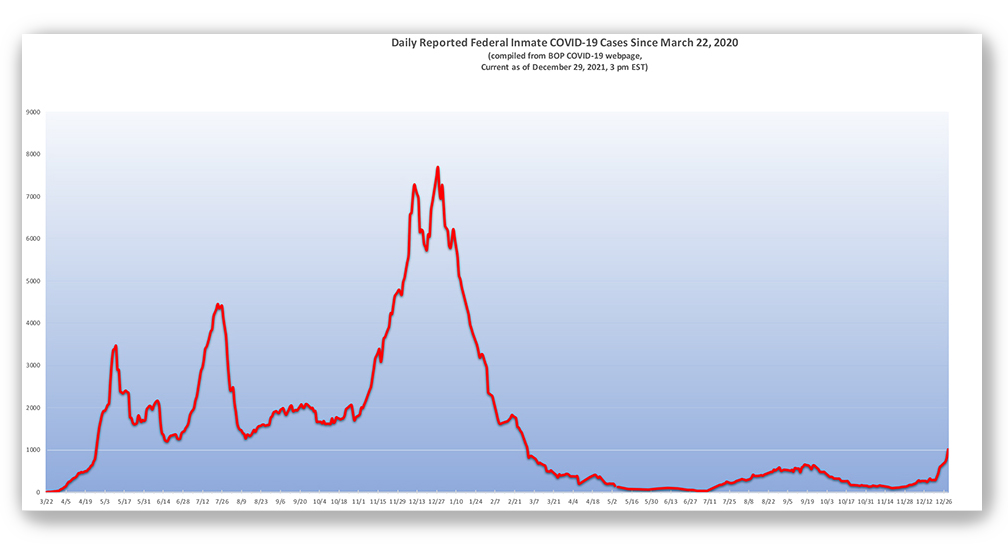We post news and comment on federal criminal justice issues, focused primarily on trial and post-conviction matters, legislative initiatives, and sentencing issues.

O-M-CHRON!
 COVID numbers, both in the Federal Bureau of Prisons and nationally, continue to shoot upward as COVID omicron has become the dominant strain of coronavirus in the USA.
COVID numbers, both in the Federal Bureau of Prisons and nationally, continue to shoot upward as COVID omicron has become the dominant strain of coronavirus in the USA.
As of last night, the BOP broke 1,000 inmate cases (1,011), up 25% in one day, with staff cases at 387, up 12% overnight. COVID was present in 114 of 122 facilities, or 93% of all BOP prisons. As of last week, the BOP reported that 73% of inmates and 69% of the staff are vaccinated.
Nationally, the country added nearly a half-million cases yesterday. Experts are estimating over 140 million people will catch COVID in the next four weeks.
The big COVID flareup in the system last week was at FPC Alderson, a female facility. Forbes reported on Christmas Eve that of the 665 “inmates at the institution, 1o8 have active COVID cases and 43 have recently recovered … over 20% are currently or recently infected.” An attorney who represents women at the facility told Forbes, “The conditions there are just abhorrent. Women are sick, there is no hot water in the quarantine unit and staff is short. I’ve contacted the mayor (of Alderson, WV), the Bureau of Prisons and anyone who will look into this crisis.” The attorney said, “there are women there who are eligible to be placed on CARES Act home confinement, but they are languishing there as the pandemic’s Omicron variant rips through the facility.”
 Monday, USP Allenwood was number one with 143 sick inmates. As of yesterday, MCC Chicago had taken the lead with 132 sick inmates as Allenwood experienced the miraculous recovery of 29 inmates. (I have written before about the BOP’s questionable “recovered” declarations. In fact, 56% of all BOP inmate COVID deaths in the last nine months have been of “recovered” inmates).
Monday, USP Allenwood was number one with 143 sick inmates. As of yesterday, MCC Chicago had taken the lead with 132 sick inmates as Allenwood experienced the miraculous recovery of 29 inmates. (I have written before about the BOP’s questionable “recovered” declarations. In fact, 56% of all BOP inmate COVID deaths in the last nine months have been of “recovered” inmates).
The Marshall Project reported last week that “as with previous iterations of the virus, ‘everything about prisons and jails makes them a setup to magnify the harms of omicron. ‘The overcrowding. The poor sanitary conditions. The lack of access to health care,’ said Monik Jimenez, an epidemiologist at Harvard’s School of Public Health. ‘Masking is only going to do so much when you have people on top of you’.”
A federal prisoner in Florida told TMP that “They’re not telling us anything about omicron or anything else for that matter.”
 The Nation reported that “Under the weight of ongoing Covid-19 outbreaks and staff vaccine refusal, sickness, death, no-shows, and rapid turnover, jails and prisons have become increasingly deadly places for those who live and work inside their walls. Failures to protect those held in America’s roughly 5,150 jails and prisons have made these institutions into taxpayer-funded epidemic engines that have driven millions of preventable Covid-19 cases throughout US communities. In response, the consensus among national health and safety experts has been that large-scale decarceration is required to protect the public. For almost two years, lawmakers have largely ignored the appeals of health leaders, incarcerated people, prison staff, and community activists who know very well that, despite claims to the contrary, mass incarceration does not serve public safety.”
The Nation reported that “Under the weight of ongoing Covid-19 outbreaks and staff vaccine refusal, sickness, death, no-shows, and rapid turnover, jails and prisons have become increasingly deadly places for those who live and work inside their walls. Failures to protect those held in America’s roughly 5,150 jails and prisons have made these institutions into taxpayer-funded epidemic engines that have driven millions of preventable Covid-19 cases throughout US communities. In response, the consensus among national health and safety experts has been that large-scale decarceration is required to protect the public. For almost two years, lawmakers have largely ignored the appeals of health leaders, incarcerated people, prison staff, and community activists who know very well that, despite claims to the contrary, mass incarceration does not serve public safety.”
Johns Hopkins University, Coronavirus Resource Center (December 29, 2021)
Institute for Health Metrics and Evaluation, University of Washington, Anticipated COVID-19 Omicron infections in United States (December 22, 2021)
Forbes, The Women’s Federal Prison Camp At Alderson In Middle Of COVID-19 Outbreak (December 24, 2021)
The Marshall Project, Omicron Has Arrived. Many Prisons and Jails Are Not Ready. (December 22, 2021)
The Nation, As Covid Surges Again, Decarceration Is More Necessary Than Ever (December 22, 2021)
– Thomas L. Root



























